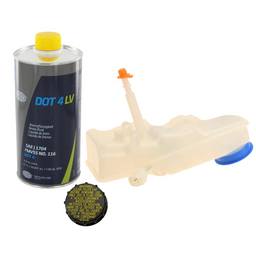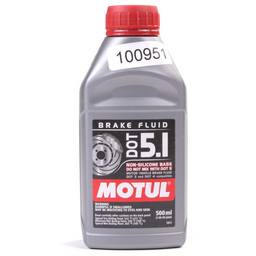When is the last time you’ve checked your brake fluid? If it took you a few seconds to answer this question, you’re among the numerous drivers who overlook what is arguably the essential fluid in a vehicle.
Today we’ll go over the most important details regarding brake fluid. We’ll explain how this fluid works, different types, and much more. By the time you’re done hanging out with us today, you’ll have all the info you could need on this subject.
Brake Fluid Explained
Brake fluid is one of those things people usually forget to check on their vehicles. That’s pretty ironic considering that this fluid is just about the only thing stopping you from smashing through a corner and potentially suffering a traumatic injury.
Understanding how the braking fluid works will allow you to understand the maintenance cycle necessary to keep it in check. This is even more important if you drive a newer vehicle with a modern ABS/ESP or any other braking assist system in place.

What Exactly is Brake Fluid?
Most people know the basic description of brake fluid – it’s the hydraulic fluid that runs the brakes on a vehicle. However, what most people don’t know is that this fluid has another purpose altogether. Your average braking system consists of a complex network of hard lines, soft lines, brake cylinders, calipers, ABS modules, and many other components. It really depends on what you drive.
That being said, brake fluid isn’t only actuating the brakes and enabling all of these components to work but also preventing them from deteriorating. Most braking systems are susceptible to corrosion. When vehicle manufacturers design new braking systems, they rely on the system continually being full of brake fluid to prevent corroding. There’s only one problem.
As it turns out, brake fluid is hygroscopic by nature. In other words, it tends to absorb moisture from the environment it’s in. The hygroscopic nature of brake fluid is precisely why it requires regular maintenance. Otherwise, they could just build a closed, maintenance-free braking system.
What Happens when Brake Fluid Draws Moisture?
When your brake fluid starts drawing moisture, two things will happen. For one, its ability to actuate the brakes will decrease. When there’s a lot of moisture in the fluid, it tends to boil under heavy use. Once you reach the boiling point, there’s not much left to actually work the calipers, the ABS, and other relevant systems. Such fluid is neither safe nor effective.
The other byproduct of having moisture in your fluid is the various braking system components’ potential corrosion. Remember, these components rely on clean fluid to keep them from rusting. Once you add water to the mix, the risk of rust increases.
How to Prevent Moisture from Entering Your Braking System?
There’s not much you can do in this regard, aside from regular maintenance. Doing a flush of the system every two years is the best way to keep everything clean and your brakes working perfectly.
One thing to remember is only to use fresh fluid from sealed containers. Never open a new bottle of brake fluid, use half of it and then leave the other half for later use. The moment you open the bottle, the fluid inside is considered compromised. Always get a new, unopened container if you’re flushing your brakes.
What is a DOT Rating?
DOT or Department Of Transport rating is a standard used worldwide to describe the wet and dry boiling point of brake fluid. These two metrics tell you how durable the brake fluid is. The higher the boiling point, the better. There are several DOT standards, although only 3 are in widespread use today.
Dry VS Wet Boiling Point Explained
Every brake fluid out there has two boiling point ratings – dry and wet boiling point. The difference between the two is simple. Dry boiling point tells you how hot the fluid can get when it’s pure. This is your fresh fluid from a new, unopened container.
Wet boiling point describes how hot the fluid can get after consuming 3.7% of water by volume. When DOTs were being standardized, 3.7% of water pollution by volume was regarded as the average level of contamination for fluid that is 2 years old.
In other words, it describes the rate of contamination within one maintenance cycle.
If you were to let the fluid sit in there for longer than 2 years, this percentage would increase, and your wet boiling point would decrease. Even though you probably wouldn’t notice this during light city driving, you’d definitely see the effects of contaminated fluid if you were to push your brakes hard.
DOT 2
DOT 2 is the oldest of the DOT ratings and is more or less never used anymore. Fluids n this range feature a dry boiling point of 190C, which is incompatible with modern braking systems.
DOT 3
Next, there’s the DOT 3 segment. This is a glycol-based fluid. DOT 3 was mainly used on older vehicles. The dry boiling point of DOT 3 is at 205C or 446 degrees Fahrenheit.
DOT 4
DOT 4 is the current standard, although it’s slowly being phased out. DOT 4 is backward compatible with DOT 3 fluid, which is why DOT 3 was rendered obsolete. DOT 4 is also a glycol-based fluid; however, it also contains Borate esters.
DOT 4+
Moving on, we have the DOT 4+ standard that is similar to standard DOT 4 except for increased dry boiling point. You’ll often find DOT 4+ used in racing vehicles as it can take the abuse of constant braking cycles without boiling.
DOT 5
As counterintuitive as it is, DOT 5 is not intended for use in active braking systems. This a silicon-based fluid meant to be used in show vehicles. It’s more of a preservative than actual brake fluid. If you were to try and use this in a street vehicle, you’d end up with no brakes pretty soon.
DOT 5.1
Despite having that 5 in its name, DOT 5.1 is a whole different beast than DOT 5. DOT 5.1 is a glycol-borate based fluid that has a high dry boiling point of 270C/500F. DOT 5.1 is backward compatible with DOT 4 and DOT 3. In fact, it’s the new standard for most vehicles.
Viscosity Levels of Modern Brake Fluids
More modern DOTs, especially the DOT 5.1, is often described as highly viscous. High viscosity brake fluids are designed to keep up with modern braking systems such as ABS, ESP, and a whole range of other modern solutions. Each of these devices requires the fluid to pass through rather tiny passages without issue. That can only be achieved if the fluid is highly viscous.
Finding Quality Brake Fluids
Here at eEuroparts.com, we’re proud of our cooperation with top brands such as Brembo and Motul. Their brake fluids are top tier and include both standard and performance options. Head over to our online store and check out our offer.
In case you’ve got questions regarding brake fluid or specific brands from our catalog, feel free to get in touch with our customer support service. Our reps are standing by to offer any assistance you need.





